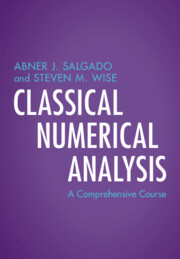Book contents
- Frontmatter
- Contents
- Preface
- Acknowledgements
- Symbols
- Part I Numerical Linear Algebra
- 1 Linear Operators and Matrices
- 2 The Singular Value Decomposition
- 3 Systems of Linear Equations
- 4 Norms and Matrix Conditioning
- 5 Linear Least Squares Problem
- 6 Linear Iterative Methods
- 7 Variational and Krylov Subspace Methods
- 8 Eigenvalue Problems
- Part II Constructive Approximation Theory
- Part III Nonlinear Equations and Optimization
- Part IV Initial Value Problems for Ordinary Differential Equations
- Part V Boundary and Initial Boundary Value Problems
- Appendix A Linear Algebra Review
- Appendix B Basic Analysis Review
- Appendix C Banach Fixed Point Theorem
- Appendix D A (Petting) Zoo of Function Spaces
- References
- Index
8 - Eigenvalue Problems
from Part I - Numerical Linear Algebra
Published online by Cambridge University Press: 29 September 2022
- Frontmatter
- Contents
- Preface
- Acknowledgements
- Symbols
- Part I Numerical Linear Algebra
- 1 Linear Operators and Matrices
- 2 The Singular Value Decomposition
- 3 Systems of Linear Equations
- 4 Norms and Matrix Conditioning
- 5 Linear Least Squares Problem
- 6 Linear Iterative Methods
- 7 Variational and Krylov Subspace Methods
- 8 Eigenvalue Problems
- Part II Constructive Approximation Theory
- Part III Nonlinear Equations and Optimization
- Part IV Initial Value Problems for Ordinary Differential Equations
- Part V Boundary and Initial Boundary Value Problems
- Appendix A Linear Algebra Review
- Appendix B Basic Analysis Review
- Appendix C Banach Fixed Point Theorem
- Appendix D A (Petting) Zoo of Function Spaces
- References
- Index
Summary
We present several methods for approximating the spectrum of a matrix. We start by providing coarse estimates using so-called Gershgoring disks. The stability, via the Bauer-Fike theorem is then analyzed. For Hermitian matrices we then present and analyze the power iteration method and its variants. The reduction to Hessenberg form, and the QR algorithm are then presented and analyzed. The chapter then concludes with a discussion of the Golub-Kahan algorithm to compute the SVD.
Information
- Type
- Chapter
- Information
- Classical Numerical AnalysisA Comprehensive Course, pp. 197 - 228Publisher: Cambridge University PressPrint publication year: 2022
